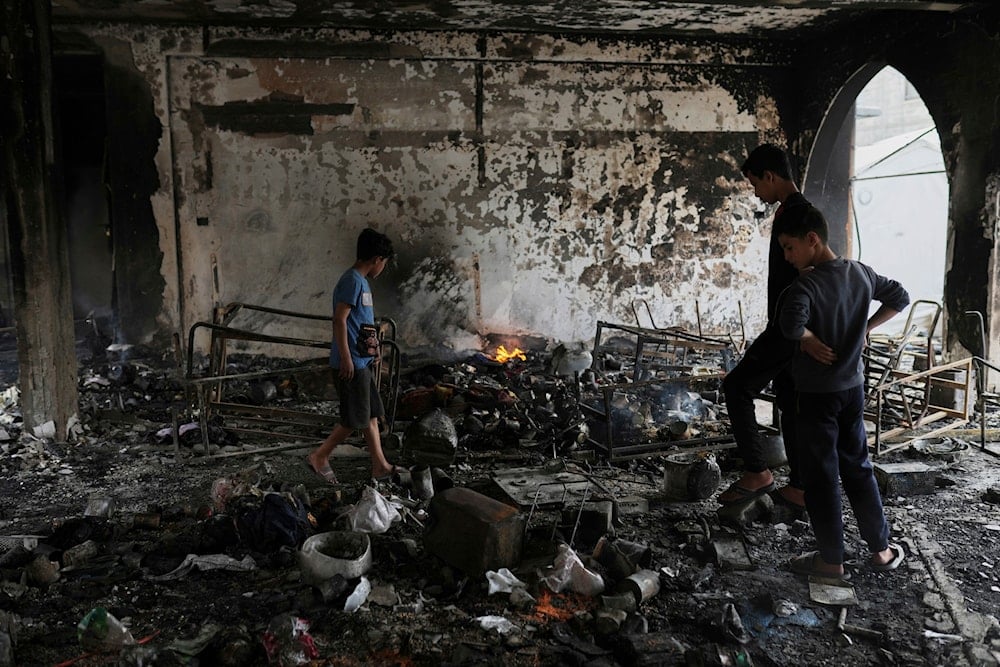Asbestos endangers Gazan lives amid the Israeli war: BBC
As Gazans grapple with the harsh realities of life under war, asbestos is dispersed in the air from airstrikes on buildings, posing a massive health risk that will have long-term effects over the next decades.
-

Palestinians inspect the damage caused by an Israeli army airstrike on Yaffa School, in Gaza City, Wednesday, April 23, 2025. (AP)
"Israel's" military campaign in Gaza has not only caused widespread destruction but also unleashed a silent killer, asbestos, a mineral once commonly used in building materials, which releases carcinogenic toxic fibers.
According to the United Nations Environment Programme (UNEP), asbestos in Gaza is primarily found in roofing materials across the territory's eight urban refugee camps, established for Palestinians who were displaced or forced from their homes during the 1948-49 Nakba.
In October 2024, UNEP released an estimate suggesting that as much as 2.3 million tons of rubble scattered throughout Gaza could contain asbestos contamination.
"The Gaza rubble is a very, very toxic environment," Professor Bill Cookson, director of the National Centre for Mesothelioma Research in London told the BBC, emphasizing that "People are going to suffer acutely, but also in the longer term as well, things that children may carry throughout their lives."
"The lives lost now are not going to end here. The legacy is going to continue," said Liz Darlison, CEO of Mesothelioma UK, according to the BBC.
When an air strike or similar disturbance breaks apart asbestos-containing materials, microscopic fibers, invisible to the naked eye, become airborne where they can be inhaled by nearby individuals, eventually penetrating deep into the delicate lining of the lungs.
Over the long term, these inhaled fibers can trigger progressive scarring within the lung tissue, a destructive process that may develop into asbestosis, a severe pulmonary disease, or potentially escalate into mesothelioma, an aggressive and often fatal form of lung cancer.
"Mesothelioma is a terrible, intractable illness," Professor Crookson said, emphasizing that "The really worrying thing, is that it's not dose related. So even small inhalations of asbestos fibre can cause subsequent mesothelioma. It grows within the pleural cavity. It's extremely painful. It's always diagnosed late. And it's pretty well resistant to all treatments."
Mesothelioma typically develops 20 to 60 years after initial asbestos exposure, creating a delayed health crisis that means Gaza may not see the full consequences for decades, while medical experts indicate that both higher concentrations and prolonged periods of exposure can dramatically speed up the disease's progression.
Dr. Ryan Hoy, whose research on dust inhalation was referenced by UNEP, explains that avoiding asbestos fibers is exceptionally challenging due to their microscopic size, as they are "really tiny particles that float in the air and can penetrate deep into the lungs," a risk further compounded by Gaza's extreme population density, which makes exposure even harder to prevent.
Gaza, with a population of roughly 2.1 million people, occupies just 365 square kilometers, making its land area about one-fourth the size of London while accommodating this dense concentration of residents.
Asbestos risk ignored amid Gaza war
"At this point in time, [dust inhalation] is not something that is perceived as a worrying thing by the population. They even don't have things to eat, and they're more afraid to be killed by the bombs," according to Chiara Lodi, who serves as the medical coordinator in Gaza for the humanitarian organization Médecins Sans Frontières.
"The lack of awareness about the risks of asbestos, combined with the ongoing challenges [people in Gaza] face in trying to rebuild their lives, means they are unable to take the necessary measures to protect themselves," said a representative from the humanitarian organization SOS Children's Villages.
They added that many people in Gaza are "not fully aware of the harmful effects of the dust and debris".
Following the 2009 conflict in Gaza, a United Nations survey conducted across the territory revealed the presence of asbestos in various structures, including older buildings, temporary extensions, storage sheds, roofing materials, and even the walls of animal enclosures, demonstrating the widespread contamination left in the wake of destruction.
Asbestos not the only risk
Beyond the well-documented dangers of asbestos, another significant but often overlooked health threat emerges from silica dust exposure, which can lead to the development of silicosis, a debilitating lung disease.
Silica dust is a harmful particulate created when cutting, grinding, or drilling materials like concrete, stone, or sand.
According to the BBC, Dr. Hoy warns that Gaza's overwhelming dust concentrations may trigger a cascade of respiratory health complications ranging from heightened susceptibility to upper and lower respiratory tract infections and pneumonia to severe aggravations of pre-existing conditions such as asthma.
He also noted that acute dust exposure could potentially accelerate the development or progression of chronic pulmonary disorders, including emphysema and chronic obstructive pulmonary disease.
As competing reconstruction plans for Gaza emerge from the United States and a coalition of Arab states, United Nations officials emphasize the critical need for meticulous management of the rebuilding process to prevent the dangerous dispersal of asbestos-laden debris that currently permeates the territory's extensive rubble fields.
"Unfortunately," Ms Darlison told the BBC, "the very properties that made us use so much of it are the properties that make it difficult to get rid of."
A UNEP spokesperson warned the BBC that debris removal operations could significantly heighten risks of asbestos disturbance, potentially releasing dangerous fibers into the atmosphere, while a separate UNEP assessment projected that the complete clearance of rubble might require up to 21 years of continuous effort with financial costs potentially reaching $1.2 billion (£929 million).

 5 Min Read
5 Min Read








